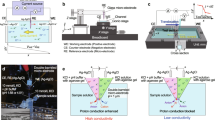Abstract.
Quartz glass electrodes are superior to conventional glass electrodes for low-noise recording. They have better electrical characteristics and hydrophobic surfaces which resist creeping of salt solutions. We used oxy-hydrogen heating with program-controlled gas pressure to melt quartz glass capillaries. Usually, the relative wall thickness (the quotient of the outer and inner diameters d o/d i) of capillaries is, at best, maintained up to the electrode tip. If tips with thicker walls can be produced, coating and other surface treatments can be avoided. We found that programmed heating periods without pull allowed an fivefold increase of d o/d i in the tip region. Since d o/d i is inversely proportional to input capacity, the recording noise was minimized and became insignificant relative to amplifier and holder noise. A sample patch-clamp recording is shown.
Similar content being viewed by others
Author information
Authors and Affiliations
Additional information
Received after revision and accepted: 3 July 2000
Electronic Publication
Rights and permissions
About this article
Cite this article
Dudel, J., Hallermann, S. & Heckmann, M. Quartz glass pipette puller operating with a regulated oxy-hydrogen burner. Pflügers Arch - Eur J Physiol 441, 175–180 (2000). https://doi.org/10.1007/s004240000407
Received:
Issue Date:
DOI: https://doi.org/10.1007/s004240000407




